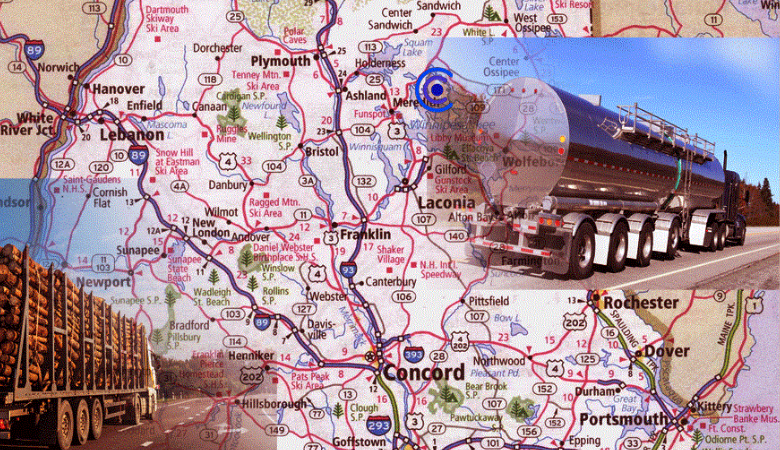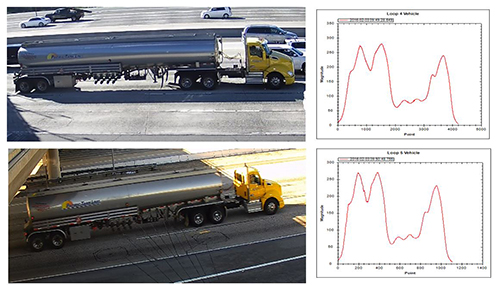Using Vehicle-Sensing Technology to Evaluate Road Safety
SBIR awardee CLR Analytics’ vehicle signature technology leveraged in New Hampshire SMART grant award

THE CHALLENGE
Funding Agency: FHWA
Small business: CLR Analytics Inc. https://www.clr-analytics.com/
Project: Transportation System Performance Measurement Using Existing Loop Infrastructure
Principal Investigator: Lianyu Chu, PhD
Location: Irvine, CA
Every day, trucks, construction vehicles, and other Commercial Motor Vehicles (CMVs) carry out essential services and deliver goods across the country. The state of New Hampshire had identified a need for more accurate and reliable traffic data, particularly about trucks and other CMVs, which form the backbone of goods shipping in the state. Road safety is a pressing issue in New Hampshire, which has experienced an unprecedented increase in traffic fatalities. Between 2019 and 2022, New Hampshire saw a disturbing 47% increase in traffic fatalities according to data from the National Highway Traffic Safety Administration (NHTSA). The heavy presence of CMVs on the state’s highway system is leading to concerns not only about road safety, but also pavement damage and air pollution. Overweight trucks can be at risk of tipping over and can damage bridges and other road infrastructure. Understanding vehicle type, weight and spacing on the road system is critical for assessing safety risks like these. CMVs also emit different amounts of pollution depending on a range of factors, and in New Hampshire there is particularly a concern that disadvantaged communities in the state are bearing the brunt of this pollution from CMVs. Accurate data about truck type, weight, travel speed, routing, and pollution are needed to better understand and plan around safety, health, and environmental concerns.
THE TECHNOLOGY
CLR Analytics, a small business that specializes in advanced traffic sensing technologies and modeling, developed an Artificial Intelligence-based sensor technology through two rounds of DOT SBIR Phase I and Phase II award funding sponsored by the Federal Highway Administration. In their SBIR research, CLR Analytics developed a new data-collection system that takes advantage of existing inductive loop detectors (ILD), a technology that is already built into the asphalt in many highway systems, to produce Inductive Loop Signatures (ILS) for vehicles, a type of vehicle-specific data. ILS technology uses existing ILDs in roadways to gather novel types of data about vehicles that pass over the sensors at a low cost. The ILS technology developed in CLR’s SBIR projects can detect vehicle type, vehicle speed, vehicle spacing, travel trajectory, and more; sensors can function even in harsh weather conditions and at night.

New Hampshire currently does not have granular data vehicle data collection methods, so the New Hampshire Department of Transportation (NHDOT) partnered with CLR Analytics to apply to the U.S. DOT’s Strengthening Mobility and Revolutionizing Transportation (SMART) Grants Program. The SMART program was established to provide grants to eligible public sector agencies to conduct demonstration projects focused on advanced smart community technologies and systems in order to improve transportation efficiency and safety. NHDOT’s proposal to use smart sensors using ILS technology to capture granular vehicle signature data about CMVs on New Hampshire’s highway system was selected for award in March 2024. NHDOT and CLR Analytics also plan to integrate new sensors with ILS data to gather pollution, temperature, and humidity data to better assess air quality and road safety.
SBIR’S ROLE
Lianyu Chu, President of CLR Analytics, noted that when the company started working on this sensor technology, there was a fundamental lack of high-quality data that researchers and state DOTs could use to understand vehicle traffic at a granular, individual vehicle level. “SBIR gave us a chance to solve that problem from the root,” and develop technology to provide an accurate, usable data source end users can analyze.
“SBIR really made CLR Analytics change from a consulting company to an R&D company and allowed us to do something we really think helped change the industry,” said Chu. “Without SBIR, basically, we couldn’t develop the kind of technology that we got because no hardware to support our technology existed.” SBIR Phase I funding allowed them to first conduct a feasibility study in Phase I, and then develop the necessary hardware and software systems in Phase II, Chu said.
Chu also noted that the SBIR process helped CLR Analytics identify potential customers and market needs during the award period. And even today, being able to point to federal research work helps CLR Analytics connect with end users like state DOTs. “When the federal [government] has interest in the technology, it is easier for the states to adopt the technology.”
THE FUTURE
Moving forward, Chu says CLR Analytics plans to continue to look for partnerships with state DOTs, such as the collaboration with NHDOT through the SMART Grants Program. Additionally, the ILS technology developed in CLR’s SBIR research is now being piloted in an FHWA transportation pooled fund study with 20 state DOTs to demonstrate applications of the technology.
Chu says CLR Analytics will apply their expertise to new sensor technologies that don’t require inductive loop detectors (ILDs). The company is conducting early-stage research on smart sensors that use video or thermal cameras and artificial intelligence through another SBIR award. “We are trying to utilize our knowledge regarding what we’ve developed and also use our background in Artificial Intelligence … to find more solutions.”
